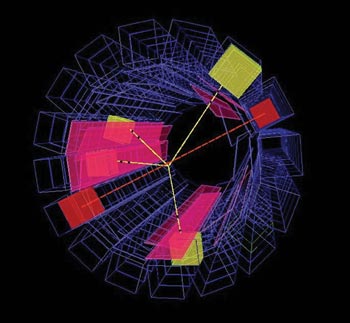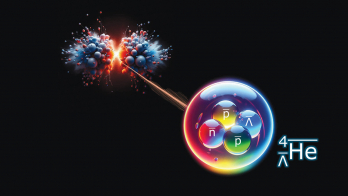
Physicists working at CERN’s Antiproton Decelerator (AD) have announced the first controlled production of large numbers of antihydrogen atoms at low energies. This is an important step on the way to testing the fundamental symmetry CPT through comparison of hydrogen with antihydrogen.
The hydrogen atom is the most completely understood atomic system, with its first excited state being pinned down to just 1.8 parts in 1014. Antihydrogen, on the other hand, is almost completely unknown. A comparison of the two systems would give a very precise test of CPT symmetry, which is assumed to be conserved in the Standard Model of particle physics. CPT is the combination of charge conjugation, parity and time reversal. The violation of the CP combination is well established in kaon and B-meson decays, but so far, no experiments have shown evidence that CPT is not conserved in nature.
This latest development at CERN follows the production of small numbers of fast-moving antihydrogen atoms at CERN and Fermilab in the US in the mid-1990s. It is the result of several years of development work into the antiparticle trapping and mixing systems needed to produce slow (cold) antihydrogen atoms that can themselves be trapped for further study. ATHENA, one of two CERN experiments that plan to study antihydrogen, has been the first to produce cold antihydrogen atoms.
Says CERN director-general, Luciano Maiani: “The controlled production of antihydrogen observed in ATHENA is a great technological and scientific event. Even more so because ATHENA has produced antihydrogen in unexpectedly abundant quantities.” Giving due credit to the ATRAP experiment (which also aims to study antihydrogen), he went on to say: “I’d like to recognize the contribution of ATRAP, which has pioneered the technology of trapping cold antiprotons and positrons, an essential step towards the present discovery.” Last year the ATRAP experiment was the first to use cold positrons to cool antiprotons.
The ATHENA collaboration of 39 scientists from nine institutions worldwide has built on these techniques with the addition of a high-yield positron accumulator and powerful particle detector. The abundant numbers of positrons from the accumulator, coupled with good granularity and background rejection from the detector, allowed the collaboration to see its first clear signals for antihydrogen in August – appropriately, the 100th anniversary of the birth of theorist Paul Dirac, who predicted the existence of antimatter in the late 1920s.
The ATHENA collaboration estimates that some 50 000 antihydrogen atoms were created in its apparatus before announcing their result. Antiprotons decelerated by the AD to a leisurely pace – by CERN’s standards – of a tenth of the speed of light were first trapped in an electromagnetic cage. From each AD pulse of 2 ¥ 1o7 antiprotons, some 10,000 were caught. The next stage was to mix them with about 75 million cold positrons collected from the decay of a radioactive isotope and caught within a second trap. Finally, the trap doors were opened, allowing the antiprotons and positrons to mix in a third trap. It is here that cold antihydrogen atoms formed.
ATHENA observes antihydrogen atoms when they annihilate with the walls of the mixing trap. Two photons from the positron annihilation are localized in space and time with charged particles coming from the antiproton annihilation. The next steps are to trap antihydrogen atoms and add a laser spectroscopy system. This will allow the CPT studies to begin.







